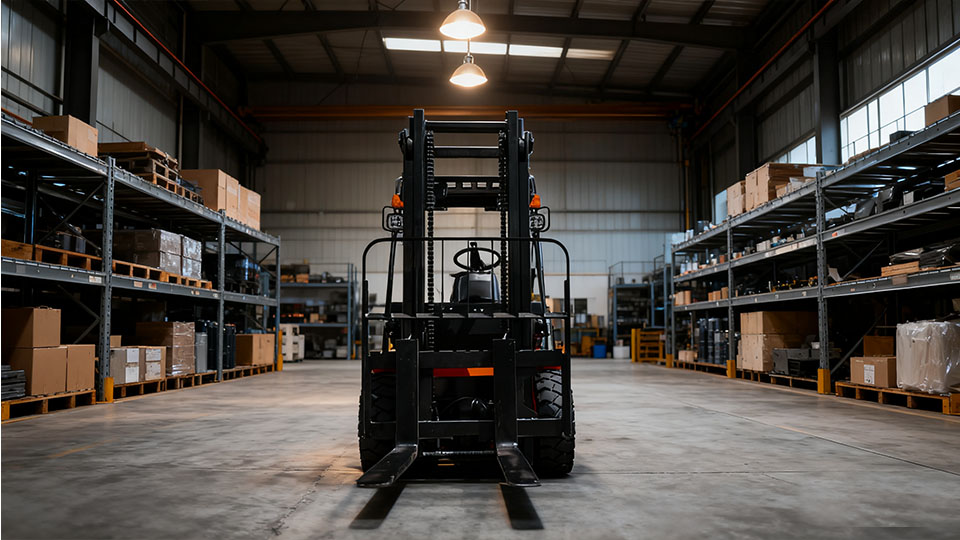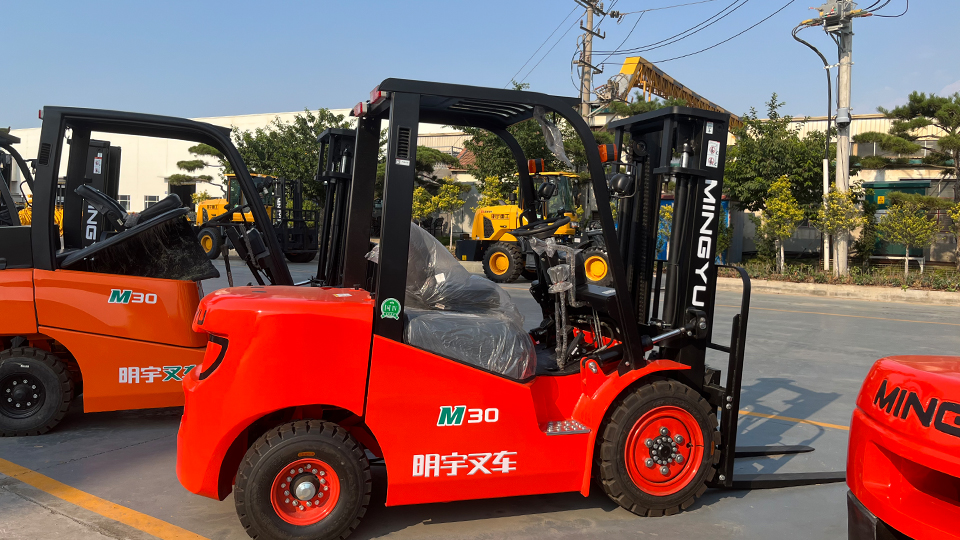
How Much Does the Forklift Weigh? A Deep Dive into Industrial Truck Mass and Stability Engineering
The industrial forklift, or powered industrial truck, is a ubiquitous piece of equipment, forming the backbone of global supply chains. While its lifting capacity is the commonly cited metric, the machine’s operating weight (also known as the gross or service weight) is arguably the most critical and complex technical specification. The weight of a forklift is not arbitrary; it is a meticulously calculated parameter determined by the laws of physics, safety regulations, and the fundamental principle of the counterbalance system.
Understanding a forklift’s weight—how it is derived, what factors influence it, and its relationship to lift capacity—is essential for safe operation, facility design (floor load capacity), and logistical planning (transportation requirements). This article will provide a comprehensive technical analysis of forklift mass, moving beyond simple averages to explore the engineering and classification that defines this crucial measurement.

The Fundamental Principle: Weight vs. Capacity
It is vital to first distinguish between two separate, yet interdependent, measurements:
Lifting Capacity (Rated Capacity): The maximum weight the forklift is engineered to safely lift and carry at a specific, designated load center. This value is prominently displayed on the forklift's data plate (nameplate).
Gross Weight (Operating Weight/Service Weight): The actual mass of the forklift itself, including the chassis, mast, counterweight, power source (fuel or battery), and any standard attachments.
In a typical counterbalanced forklift design, the vehicle’s operating weight is significantly greater than its rated lifting capacity. This is an intentional engineering necessity. A general rule of thumb for standard counterbalance forklifts is that the gross weight is approximately 1.5 to 2 times its rated lifting capacity. For instance, a forklift with a 5,000 lb capacity will typically weigh between 7,500 and 10,000 lbs.
The purpose of this disproportionate weight is to maintain the forklift’s stability by ensuring the entire system's center of gravity remains within the Stability Triangle—an imaginary boundary connecting the front axle pivot points and the center of the rear axle. When a load is lifted, it generates an overturning moment that attempts to tip the truck forward. The weight of the forklift acts as a counteracting force, generating a moment of stability.
The Anatomy of Mass: Where Forklift Weight Resides
A forklift’s gross weight is an aggregate of several heavy components, each contributing to the overall stability and functionality:
1. The Counterweight (The Engineered Anchor)
The single heaviest non-structural component on a counterbalanced forklift is the counterweight, a massive slab of cast iron or steel located at the rear of the truck. Its entire function is to offset the load and the mast assembly.
Average Weight Contribution: Counterweights on standard industrial trucks commonly weigh between 3,000 to 5,000 lbs but can be much heavier on high-capacity models.
The Lever Principle (Load Moment): The calculation of the required counterweight is a direct application of the law of the lever, which governs torque and equilibrium.
=Forklift Weight×Distance of Center of Gravity from Fulcrum
The fulcrum (pivot point) for a counterbalanced forklift is the center of the front axle. Forklift engineers carefully design the counterweight's mass and its distance from the fulcrum to ensure the truck's maximum rated capacity is safely lifted under standard conditions.
2. The Power Source (Battery vs. Engine)
The source of power is a primary determinant of a forklift's operating weight, particularly in the most common Class I (Electric Rider) and Classes IV/V (Internal Combustion) categories.
Electric Forklifts (Class I): These units lack an engine block but utilize incredibly heavy industrial batteries. A standard 36-volt or 48-volt forklift battery can weigh from 1,500 lbs up to 3,000 lbs or more. This massive, dense weight is strategically placed low in the chassis to form an integral part of the counterweight system, enhancing lateral stability and lowering the overall center of gravity.
Internal Combustion (IC) Forklifts (Classes IV and V): Powered by gasoline, LPG, CNG, or Diesel, these trucks rely on a conventional engine block, transmission, and fuel tank system. Diesel engines, in particular, are built for extreme durability and heavy-duty applications, making them significantly heavier than LPG or electric models. For the same lift capacity, an IC truck will typically be heavier than an electric model that uses its battery for counterweight.
3. Mast and Frame Construction
The mast assembly and the heavy-gauge steel frame form the core structure. A higher-capacity or higher-lifting forklift requires a more robust, multi-stage mast and heavier steel construction, contributing substantial additional weight.
Multi-Stage Masts: A quad or telescoping mast, required for high-reach applications, includes additional hydraulic cylinders, chain assemblies, and reinforced channels that can add hundreds to over a thousand pounds compared to a simpler two-stage mast.
Tire Type: The tires themselves, and the corresponding wheel and axle components, affect weight. Cushion-tire forklifts (designed for smooth indoor use) are generally lighter than pneumatic-tire forklifts (Class V), which have larger, heavier tires and reinforced suspensions for rough outdoor terrain.

Weight Ranges by Forklift Classification (ITA Classes I-V)
The Industrial Truck Association (ITA) classifies forklifts into seven distinct classes. The operating weight varies dramatically across these categories, directly correlating with their intended use and lift capacity.
ITA Forklift Class Type of Truck (Example) Typical Operating Weight Range (lbs) Notes on Weight
I Electric Motor Rider (Counterbalance) 4,000 – 20,000+ Weight heavily influenced by the industrial battery pack. Standard models are often 6,000–8,000 lbs.
II Electric Motor Narrow Aisle (Reach, Turret) 3,000 – 5,000 Lighter due to reduced need for massive counterbalance. Stability achieved via outriggers or straddle arms.
III Electric Motor Hand/Hand-Rider (Pallet Jack, Stacker) 2,500 – 4,500 The lightest category. Mass is minimal, designed for low-level lifting and transporting.
IV Internal Combustion Engine (Cushion Tire) 7,000 – 15,000 Typically warehouse IC trucks. Weight is focused on the engine, chassis, and counterweight.
V Internal Combustion Engine (Pneumatic Tire) 8,000 – 100,000+ The weight is significantly higher due to larger engines, reinforced frames, and heavy-duty tires for outdoor use.
VII Rough Terrain (Telehandlers) 12,000 – 50,000+ Extreme weight required for stability on uneven ground and extended reach applications.
Note: The overall average weight for a common warehouse forklift (Class I or IV) is often cited at approximately 8,000 to 9,000 lbs.
The Operational Significance of Forklift Weight
The weight of the forklift is not just a technical detail; it is a critical variable in three major operational areas:
1. Floor Loading and Facility Planning
Every industrial facility floor is engineered with a specific load rating (measured in pounds per square inch or PSF). A fully loaded forklift exerts a significant amount of concentrated force on the floor.
Total Weight Calculation: The weight of the forklift plus its maximum rated load must be considered. A 9,000 lb truck lifting a 5,000 lb load results in 14,000 lbs of dynamic pressure.
Concentrated Force: The pressure exerted is not evenly distributed but is concentrated primarily on the front wheels (the fulcrum), which must bear the combined load, counterbalanced by the rear wheels. Engineers must confirm that the floor's load-bearing capacity exceeds the maximum gross weight of the equipment operating within the facility to prevent structural damage.
2. Transportation and Logistics
When a forklift needs to be moved between sites or transported for service, its exact weight is mandatory information for safe and legal movement.
Shipping Weight: The total weight dictates the capacity of the trailer or flatbed required.
Ramp Capacity: When loading a forklift onto a truck, the combined weight of the forklift and the operator must not exceed the specified capacity of the loading ramp.
3. Derating Capacity and Attachments (The Dynamic Factor)
Any modification to a forklift that alters its center of gravity or increases its total mass directly impacts its stability and must be accounted for.
Attachments: Adding an attachment like a side-shifter, carton clamp, or drum rotator increases the truck’s overall weight and, more critically, shifts the load center forward. This reduces the effective maximum lifting capacity (a process called derating).
Recalculation: Federal safety standards (e.g., OSHA in the United States) require a new, permanently affixed data plate if the forklift is modified. The new capacity is calculated by factoring the attachment’s weight and its effect on the load moment.
Conclusion
The question "How much does a forklift weigh?" has no single answer, but a complex, technically-driven range defined by its engineered purpose. The average industrial forklift weighing in the range of 8,000 to 10,000 pounds is not an arbitrary number; it is the calculated weight required to safely counteract a significant overturning force.
For any professional operating, purchasing, or managing industrial equipment, the true operating weight is the most crucial figure to know—found directly on the manufacturer’s data plate. It is the silent, heavy guarantor of the stability triangle, dictating not only what the machine can lift, but where it can safely operate and how it must be handled during transport. The gross weight is the foundation upon which the entire safety and efficiency of modern material handling is built.
Name: selena
Mobile:+86-13176910558
Tel:+86-0535-2090977
Whatsapp:8613181602336
Email:vip@mingyuforklift.com
Add:Xiaqiu Town, Laizhou, Yantai City, Shandong Province, China